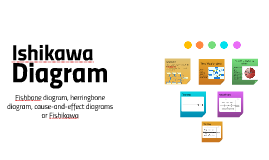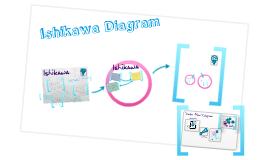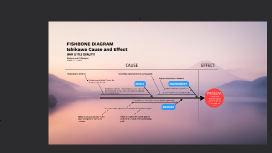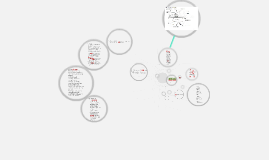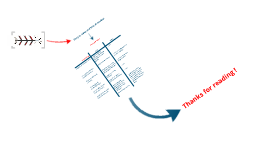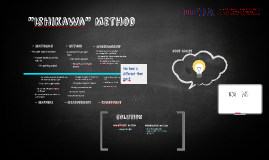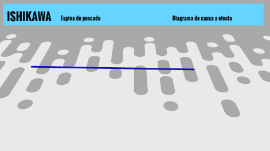ISHIKAWA
Transcript: Summary of one relevant paper The History of Ishikawa by Monster Univesity CONCLUSION The fishbone diagram and analysis was very innovative and efficient way of resolving key issues of the organizations. It has some draw backs but that doesn’t minimize the wonderful way of analysis it provides. Ishikawa Diagram used the concept of fishbone It is known as the fishbone diagram because it is shaped like a fish bone. The Basic use of this tool is to find the root cause of a problem. The main concept of this diagram is when a problem is included in the diagram and placed at the right of the diagram at the end of the main 'bone.' Along the bone, there are 5 to 7 sub-bone placed to find the main cause of the problem being discussed. At every single sub-bone, it will put a cause that has caused a problem occurs. Causes are usually grouped into major categories which are men , machine , method , material and environment. When fishbone diagram is complete, an individual has had a fairly clear idea of the problems discussed and the causes of the problem. When an individual have an idea about the problems discussed, he/she must find a solution to solve the problem. Second fishbone Problem and solution 1.Lack of Proper Equipment :undertake a comprehensive program 2.Faulty Process :to adopt an Electronic ordering system 3.Misdirected People :motivate them and keep them on right track 4.Materials Managed Poorly :adopt centralize ordering system 5.Improper Environment :involving employees 6.Inefficient Management :recruit more talents http://www.kfmaas.de/q_ishika.html http://www.mindtools.com/pages/article/newTMC_03.htm asq.org/learn-about-quality/cause-analysis-tools/overview/fishbone.html Tarun Kanti Bose, Assistant Professor, Business Administration Discipline, Khulna University, Khulna-9208, Bangladesh Application of Fishbone Analysis for Evaluating Supply Chain and Business Process-A CASE STUDY ON THE ST JAMES HOSPITAL Vol. 3, No. 2, June 2012 Refferences Journal Topic : Application of Fishbone Analysis for Evaluating Supply Chain and Business Process- A CASE STUDY ON THE ST JAMES HOSPITAL Kaoru Ishikawa Born July 13, 1915 Tokyo, Japan Fields quality, chemical engineering Institutions University of Tokyo, Musashi Institute of Technology 1939 he graduated University of Tokyo with an engineering degree in applied chemistry. he worked as a naval technical officer from 1939-1941 Between 1941-1947 Ishikawa worked at the Nissan Liquid Fuel Company 1947 Ishikawa started his academic career as an associate professor at the University of Tokyo undertook the presidency of the Musashi Institute of Technology in 1978. In 1949, Ishikawa joined the Japanese Union of Scientists and Engineers (JUSE) quality control research group After becoming a full professor in the Faculty of Engineering at The University of Tokyo (1960) Ishikawa introduced the concept of quality circles (1962) in conjunction with JUSE Among his efforts to promote quality were the Annual Quality Control Conference for Top Management (1963) and several books on quality control (the Guide to Quality Control was translated into English). Ishikawa was involved in international standardization activities 1982 saw the development of the Ishikawa diagram which is used to determine root causes. Died April 16, 1989 (aged 73) The advantages of quality approach CASE STUDY The case study of the St James Hospital and Lucas This case study reveals that the main problems of the hospital were its supply chain management inefficiency and analysis on different classic categories of the fishbone outlined the causes. ISHIKAWA reduce defect improve product quality increase reliability reduce costs waste is identified and reduced rework is identified and reduced improvement techniques are established inspection and after-the-fact expenses are reduced contracts are rationalized sales and market opportunities are increased company reputation is increased interdepartmental barriers are broken down and ease communication false and inaccurate data is reduced meeting are more effective and focused repairs and maintenance are rationalized improvement in human relations improvement in human relations quality improvement becomes a norm MAIN APPLICATION Tool for analyzing the business process and its effectiveness. This study was intended towards evaluating the supply chain and business process of St. James Hospital Its reveals that the hospital is facing immense problem to ensure sound supply chain management As a result the hospital is increasingly failing to maintain its well established and long lasted reputation. In this fishbone analysis the causes of the inefficient supply chain management of the hospital will be uncovered and simultaneously solution will be provided to get back to the operational excellence (Bence, 1995) In first fishbone diagram there are six classic categories of a fishbone diagram which are categorized as the main causes of any problems of business process. Those are






